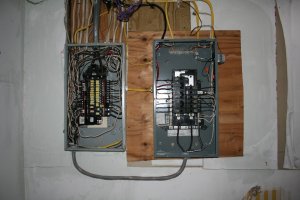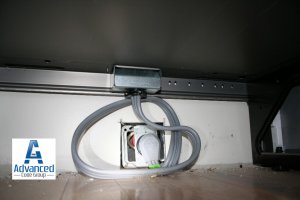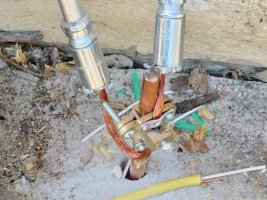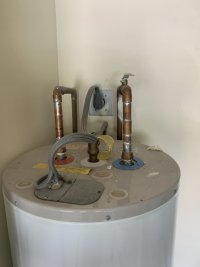-
Welcome to The Building Code Forum
Your premier resource for building code knowledge.
This forum remains free to the public thanks to the generous support of our Sawhorse Members and Corporate Sponsors. Their contributions help keep this community thriving and accessible.
Want enhanced access to expert discussions and exclusive features? Learn more about the benefits here.
Ready to upgrade? Log in and upgrade now.
You are using an out of date browser. It may not display this or other websites correctly.
You should upgrade or use an alternative browser.
You should upgrade or use an alternative browser.
The Official Electrical Violation Photo Thread
- Thread starter jar546
- Start date
steveray
SAWHORSE
GEC goes to the meter, not to the "service"...No MBJ...
110.34 Work Space and Guarding.
(A) Working Space. Except as elsewhere required or permitted in this Code, equipment likely to require examination, adjustment, servicing, or maintenance while energized shall have clear working space in the direction of access to live parts of the electrical equipment and shall be not less than specified in Table 110.34(A).
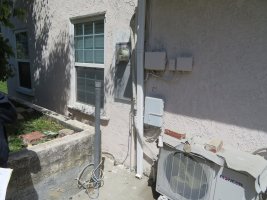
This is a service upgrade. I was told that Edison spotted the meter here. The indications are that the previous cabinet was right where this one is now.
(A) Working Space. Except as elsewhere required or permitted in this Code, equipment likely to require examination, adjustment, servicing, or maintenance while energized shall have clear working space in the direction of access to live parts of the electrical equipment and shall be not less than specified in Table 110.34(A).

This is a service upgrade. I was told that Edison spotted the meter here. The indications are that the previous cabinet was right where this one is now.
Last edited:
110.3 Examination, Identification, Installation, and Use of Equipment.
(B) Installation and Use. Listed or labeled equipment shall be installed and used in accordance with any instructions included in the listing or labeling.
110.12 Mechanical Execution of Work. Electrical equipment shall be installed in a neat and workmanlike manner.
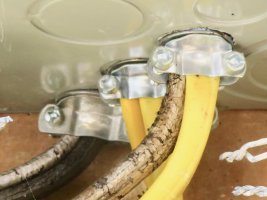
(B) Installation and Use. Listed or labeled equipment shall be installed and used in accordance with any instructions included in the listing or labeling.
110.12 Mechanical Execution of Work. Electrical equipment shall be installed in a neat and workmanlike manner.

Last edited:
jar546
CBO
There are a few problems with this "perimeter bond" inspection for the perimeter surface around this pool:
1st, the perimeter bond under this method (they will not be pouring concrete or using rebar) must be 4-6" below the surface and between 18-24" away from the edge of the water. They called for an inspection way too soon as they are not finished backfilling yet and it will end up being way too low below the surface in violation of NEC 680.26(B)(2)(a)(5)
2nd By using this method under NEC 680.26(B)(2)(a) "alternate means" they will need a bare ground wire and not the insulated wire they have installed. That would be a violation of NEC 680.26(B)(2)(a)(1)
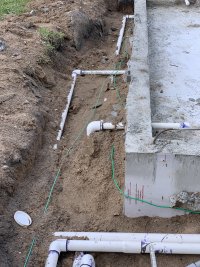
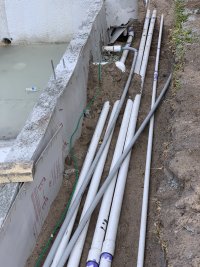
1st, the perimeter bond under this method (they will not be pouring concrete or using rebar) must be 4-6" below the surface and between 18-24" away from the edge of the water. They called for an inspection way too soon as they are not finished backfilling yet and it will end up being way too low below the surface in violation of NEC 680.26(B)(2)(a)(5)
2nd By using this method under NEC 680.26(B)(2)(a) "alternate means" they will need a bare ground wire and not the insulated wire they have installed. That would be a violation of NEC 680.26(B)(2)(a)(1)


jar546
CBO
El. service upgrade:
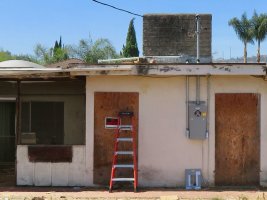
The branch circuits are in a conduit that is 5" above the roof.
The old panel enclosure has become a j-box:
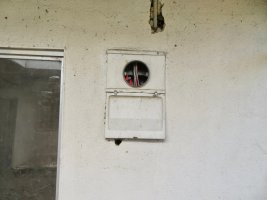
There are many things wrong.
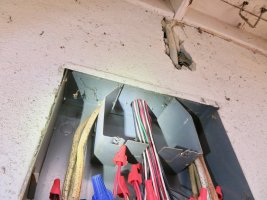
And one thing that's nearly correct:
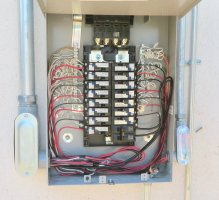
Knowing that there is a deration factor for 24 current carrying conductors in a raceway which shoots this down I ask this question: "What is the ambient temperature that must be applied?"

The branch circuits are in a conduit that is 5" above the roof.
The old panel enclosure has become a j-box:

There are many things wrong.

And one thing that's nearly correct:

Knowing that there is a deration factor for 24 current carrying conductors in a raceway which shoots this down I ask this question: "What is the ambient temperature that must be applied?"
jar546
CBO
jar546
CBO
That pic makes no sense to me whatsoever as there is probably a rod missing and trying to figure out the purpose of the conduit and romex connectors on the ends of the threaded coupler and why the rod is not all the way in the ground (if it is 8'). Expensive clamp, however.
jar546
CBO
250.97 did not apply because of the PVC used for the feeder, otherwise it would have.
That pic makes no sense to me whatsoever as there is probably a rod missing and trying to figure out the purpose of the conduit and romex connectors on the ends of the threaded coupler and why the rod is not all the way in the ground (if it is 8'). Expensive clamp, however.
Here's the other 10' rod>
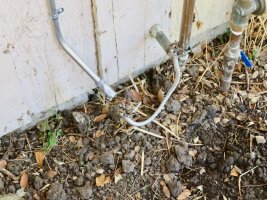
jar546
CBO
I am just going to assume that the purpose of the conduit is the reduction of copper theft?
Wrong size cover plate.Why you need to remove the bottom drawer of the range during final inspection: what violation would this be?
]
Is the sharp bend in the power cord a problem?
That or aesthetics.I am just going to assume that the purpose of the conduit is the reduction of copper theft?
jar546
CBO
TheCommish
SAWHORSE
The carpenter says incorrect connector?
jar546
CBO
The carpenter says incorrect connector?
Find a cord that is listed and labeled to be used with a water heater of a specific wattage.
Find a water heater such as this one that specifies a flexible cord that can be used with it.
That is a 125/250V rated dryer cord, non-grounding, the use of a flat cord is hokey at best, but the water heater being cord & plug connected is not kosher made worse by the plug being mounted upside down, noted by the way the right angle plug is hanging. A bad install all around.
TheCommish
SAWHORSE
The electrons do not through what conductor they flow
I checked the website for State Water Heaters, looked at a random installation guide for a residential electric heater. It says (paraphrase) install the electric service in compliance with local codes. Follow nfpa 70 and nec if no local codes. In stall wiring in an approved conduit if required by local code.Find a water heater such as this one that specifies a flexible cord that can be used with it.
That last item implies that a flexible power cord is acceptable to the mfgr.
Mr. Inspector
SAWHORSE
That is a 125/250V rated dryer cord, non-grounding, the use of a flat cord is hokey at best, but the water heater being cord & plug connected is not kosher made worse by the plug being mounted upside down, noted by the way the right angle plug is hanging. A bad install all around.
please provide the section number in the NEC that requires the respectable to be in a certain direction.
jar546
CBO
please provide the section number in the NEC that requires the respectable to be in a certain direction.
I believe it is his opinion that it is a bad install method and not a code issue.
I suspect you are right, but some inspectors demand the ground prong be up.I believe it is his opinion that it is a bad install method and not a code issue.

